Why this resume works
- Quantifies accomplishments: Measurable accomplishments, such as increasing brand visibility by 30% and coordinating over 20 fashion shoots monthly, portray the applicant’s industry influence.
- Highlights industry-specific skills: Mastery in trend analysis and sustainable fashion showcases how the applicant strategically aligns skills with current industry demands, emphasizing their role within the fashion sector.
- Showcases career progression: From textile designer to leading a team at LuxeThreads Atelier, the applicant’s career journey reflects significant growth and expanded responsibilities in the fashion domain.
More Fashion Designer Resume Examples
Explore our fashion designer resume examples to craft a standout resume that highlights your creativity, design skills, and relevant experience. These fashion resume samples provide guidance to effectively showcase your expertise to employers.
Entry-Level Fashion Designer
Why this resume works
- Effective use of keywords: By integrating role-relevant keywords like “fashion designer” and “trend analysis,” the applicant improves their chances of passing applicant tracking systems (ATS).
- Shows digital literacy: Listing skills in digital sketching and fashion forecasting showcases the applicant’s adeptness with essential computer skills for creative industries.
- Puts skills at the forefront: Placing skills like project management and creative design at the top aligns with a skills-based resume format, highlighting strengths ideal for emerging professionals.
Mid-Level Fashion Designer
Why this resume works
- Points to measurable outcomes: By showcasing a 15% sales increase and reducing supplier costs by 10%, the applicant clearly focuses on powerful results that boost performance and efficiency.
- Demonstrates language abilities: Possessing language skills in Spanish, French, and Italian improves the applicant’s ability to engage in cross-cultural communication within international fashion scenarios.
- Displays technical expertise: The applicant’s expertise with Adobe Creative Suite and certifications from top institutes signifies a strong grasp of essential design tools and techniques in the fashion industry.
Experienced Fashion Designer
Why this resume works
- Focuses on work history: The chronological resume format effectively showcases a rich tapestry of career growth, moving from textile design to leading innovative fashion projects.
- Lists relevant certifications: Listing certifications like Certified Fashion Designer and Advanced Trend Analysis Certification highlights an ongoing commitment to mastering industry trends and techniques.
- Emphasizes leadership skills: By managing over 80 annual product cycles, the applicant illustrates leadership skills, driving efficiency and innovation in fast-paced environments.
Fashion Designer Resume Template (Text Version)
Hiro Patel
Eastside, WA 98013
(555)555-5555
Hiro.Patel@example.com
Professional Summary
Dynamic fashion designer with expertise in luxury style. Proven success in designing impactful collections, enhancing brand visibility, and leading design teams to innovative achievements.
Work History
Fashion Designer
LuxeThreads Atelier – Eastside, WA
January 2022 – January 2025
- Designed 50+ seasonal collections yearly
- Increased brand visibility by 30%
- Managed a team of 7 fashion assistants
Apparel Stylist
TrendWave Fashion – Tacoma, WA
January 2020 – December 2021
- Coordinated 20+ fashion shoots monthly
- Curated outfit ideas for 15% sales boost
- Collaborated with 10+ designers on projects
Textile Designer
PatternPulse Ltd. – Eastside, WA
January 2019 – December 2019
- Developed 100+ textile patterns annually
- Reduced material costs by 20%
- Trained 5 new designers in patternmaking
Skills
- Fashion Illustration
- Patternmaking
- Textile Design
- Trend Analysis
- Team Leadership
- Creative Vision
- Adobe Creative Suite
- Sustainable Fashion
Education
Parsons School of Design New York, New York
May 2018
Bachelor of Arts Design and Media Arts
University of California, Los Angeles Los Angeles, California
May 2016
Certifications
- Certified Fashion Designer – Fashion Designers Council
- Sustainable Fashion Technician – EcoFashion Association
Languages
- French – Beginner (A1)
- Italian – Intermediate (B1)
- Spanish – Intermediate (B1)
Related Resume Guides
Advice for Writing Your Fashion Designer Resume
Dive into our advice on how to write a resume for a fashion designer role, where you’ll find tips tailored to highlight your unique flair and creative achievements. Whether you’re showcasing your design portfolio or detailing industry experience, crafting the perfect resume can set you apart in the fashion world.
Showcase your portfolio or projects
For a fashion designer, having a portfolio or projects on your resume is essential. It lets you display your creativity and skills in a way that words alone can’t. Employers want to see what you’ve done more than just read about it, especially in artistic jobs like fashion design.
Your portfolio should include pictures of your work, sketches, and completed designs. It’s also smart to link to an online platform like Behance or Dribbble, where people can easily view more of your projects.
When building your portfolio, don’t forget that freelance work, academic projects, and side gigs count too. These experiences show you’re versatile and have real-world application of your talents.
Each project should be structured clearly with the project name, who you worked for (if applicable), a short description, and what you did to make it special or successful. This helps employers quickly understand what you’re capable of. Your personal website could serve as the hub for all this information if you prefer something custom-made over existing platforms.
By showcasing select projects directly on your resume or linking them through a portfolio site, you’re giving potential employers an immediate look into how you think and create as a fashion designer.
Example of a projects section
Spring/Summer Collection 2023
Luxe Apparel
Feb 2023 – Aug 2023
- Designed a 20-piece collection featuring sustainable materials, showcased at New York Fashion Week.
- Collaborated with garment manufacturers to ensure high-quality production standards and fit.
- Developed marketing campaign visuals that increased online engagement by 50%.
Streetwear Collaboration Capsule
Urban Threads
Sep 2022 – Dec 2022
- Created a limited edition streetwear capsule in partnership with Urban Threads, focusing on eco-friendly fabrics.
- Oversaw all stages of product development from concept to final delivery, ensuring brand alignment.
- Organized pop-up events in key markets, resulting in a sell-out within the first week.
Need ideas for your resume? Check out our professional resume examples to see how to showcase your skills and work history.
Emphasize your most relevant skills
In a fashion designer role, success depends on a balance of technical expertise and soft skills. Technical abilities such as proficiency with design software like Adobe Illustrator and Photoshop are essential for creating digital sketches, patterns, and visual concepts that bring your creative ideas to life.
Equally important are soft skills like creativity, communication, and teamwork, which help you collaborate effectively and interpret client needs accurately. Including a skills section on your resume makes it easy for employers to see your qualifications at a glance.
List relevant software tools alongside artistic abilities such as sketching, draping, or fabric selection to show your versatility in the design process. You can make an even stronger impact by weaving these skills into your work experience section.
For instance, instead of simply stating that you contributed to a team project, highlight how your understanding of color theory or trend forecasting helped produce designs that exceeded client expectations. By showcasing your skills throughout your resume, you demonstrate that you’re not only technically proficient but also a strong collaborator and creative thinker.
For fashion designers, a resume format that highlights creativity, design skills, and project experience is ideal.
Choose a professional resume template
When choosing a resume template for a fashion designer role, look for one that strikes the right balance between creativity and professionalism. The design should be clean and well-structured while still reflecting your personal style. Avoid templates that are overly decorative or cluttered, as they can distract from the content of your resume.
It’s also essential to select an ATS-friendly format—one that applicant tracking systems can easily read. Use simple, legible fonts and steer clear of complex graphics or unconventional layouts that might cause scanning issues. This ensures your resume is both visually appealing to recruiters and compatible with hiring software.
By blending creativity with simplicity, you’ll create a resume that showcases your design skills while maintaining clarity and professionalism. A strong template uses visual hierarchy effectively, with clear headings and organized sections that guide the reader’s attention and make your qualifications stand out.
Show off your unique style as a fashion designer with our Resume Builder. Choose a template that matches your style and easily add your personal touch.
Format your resume properly
A proper resume format ensures your resume is both easy to read and professional-looking. For a fashion designer role, using a chronological approach works well if you have substantial experience. This format helps showcase your career growth over time, emphasizing previous roles and accomplishments in the fashion industry effectively. Here are a few tips to help you get started:
5 resume formatting tips
- Choose a professional font: Use a readable font like Arial, Calibri, or Times New Roman in 10-12 pt size.
- Organize sections clearly: Structure resume with headings (Work Experience, Skills, Portfolio) for easy navigation.
- Use bullet points: Break down job duties and achievements into concise bullet points for readability.
- Stick to one page: Aim for a one-page resume unless you have extensive experience.
- Maintain consistent margins and spacing: Ensure proper alignment with 1-inch margins for a clean, professional look.
You can use our ATS Resume Checker to scan your resume for potential issues and receive on-the-spot feedback to improve your resume score.
Salary Insights for Fashion Designers
Understanding salary data can help you make informed decisions about your career path and negotiation strategy. Explore key insights below to guide your research.
Top 10 highest-paying states for fashion designers
Fashion Designers earn varying salaries across the United States, with a national average of $79,681. The table below highlights the states where fashion designers command the highest compensation.
Our salary information comes from the U.S. Bureau of Labor Statistics’ Occupational Employment and Wage Statistics survey. This official government data provides the most comprehensive and reliable salary information for fashion designers across all 50 states and the District of Columbia. The figures presented here reflect the May 2025 dataset, which is the most recent available as of this publication.
| State | Average Salary |
|---|---|
| Oregon | $134,060 |
| Tennessee | $117,100 |
| Massachusetts | $107,560 |
| New York | $106,180 |
| Connecticut | $101,850 |
| New Jersey | $96,380 |
| New Hampshire | $90,750 |
| Missouri | $87,290 |
| North Carolina | $82,370 |
| Washington | $80,350 |
FAQ
Do I need to include a cover letter with my fashion designer resume?
Including a cover letter with your fashion designer resume is a smart move to distinguish yourself from other applicants.
A cover letter lets you express your enthusiasm for the brand and highlight your design philosophy, which might align with the company’s aesthetic and values.
For instance, if the fashion house specializes in sustainable materials or cutting-edge designs, you can discuss your passion or experience in those areas.
Consider using our Cover Letter Generator to craft a letter that complements your resume, offering expert content suggestions and step-by-step guidance tailored to the fashion industry.
Additionally, browsing various cover letter examples can provide inspiration and help ensure yours effectively communicates your skills and creativity as a fashion designer.
How long should a fashion designer’s resume be?
For a fashion designer, a one-page resume is often sufficient to highlight your creativity, technical skills, and standout projects. This format works well if you’re early in your career or transitioning into the field.
However, if you have extensive experience or notable collaborations, consider a two-page resume to adequately display your achievements and portfolio highlights.
Focus on recent work and relevant experiences that showcase your design prowess and industry impact. For more insights on how long a resume should be for different career stages, explore resources tailored to fashion professionals.
How do you write a fashion designer resume with no experience?
To craft a resume with no experience as a fashion designer, emphasize your skills, education, and any relevant projects or internships that showcase your potential in the fashion industry.
- Showcase your education: List your degree in fashion design or a related field first. Include the institution’s name, graduation date, and any honors or awards received.
- Highlight relevant coursework and projects: Mention courses or projects where you’ve created designs, developed collections, or worked with textiles. This can demonstrate practical knowledge and creativity.
- Include internships and volunteer work: If you’ve interned at a fashion house or volunteered for fashion events, detail these experiences to show involvement in the industry.
- Emphasize technical skills: Highlight skills in tools like Adobe Illustrator, Photoshop, or CAD software. These are important skills for a modern fashion designer.
For more insights on crafting an effective resume with no experience, explore guides from career experts that offer tailored advice for aspiring fashion designers.
Rate this article
Fashion Designer
Additional Resources
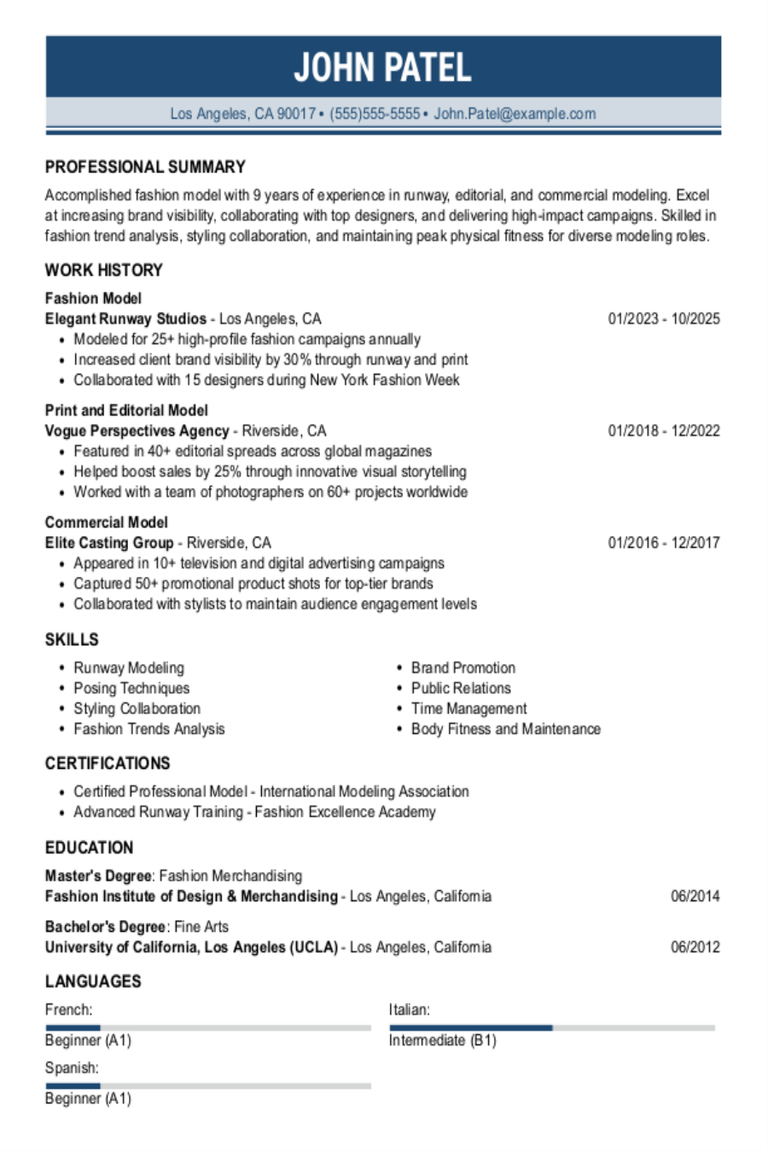
Fashion Model Resume Examples & Templates for 2025
Explore fashion model resume examples that emphasize posing abilities, runway experience, and collaborations with brands. These examples and tips can help you create a resume that showcases your unique style
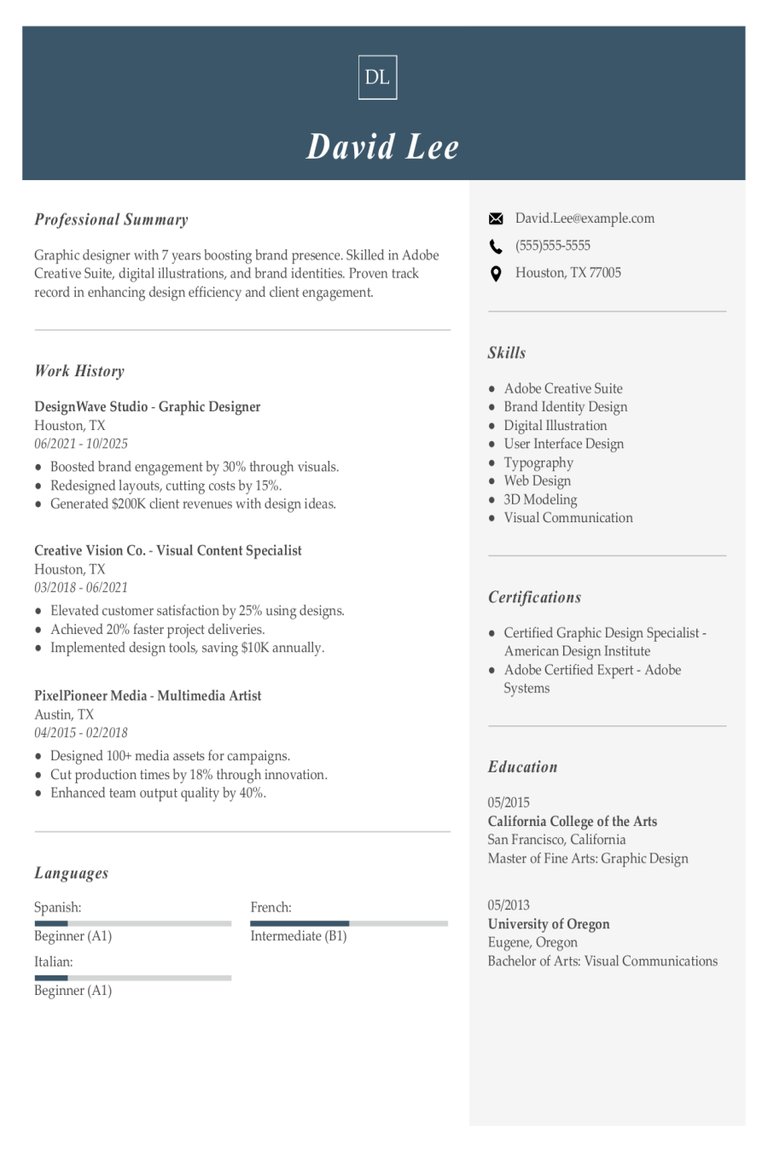
Graphic Designer Resume Examples & Templates for 2025
Explore graphic designer resume examples to learn how to showcase your creativity, design expertise, and project experience. These examples and tips can help you demonstrate your ability to craft visually
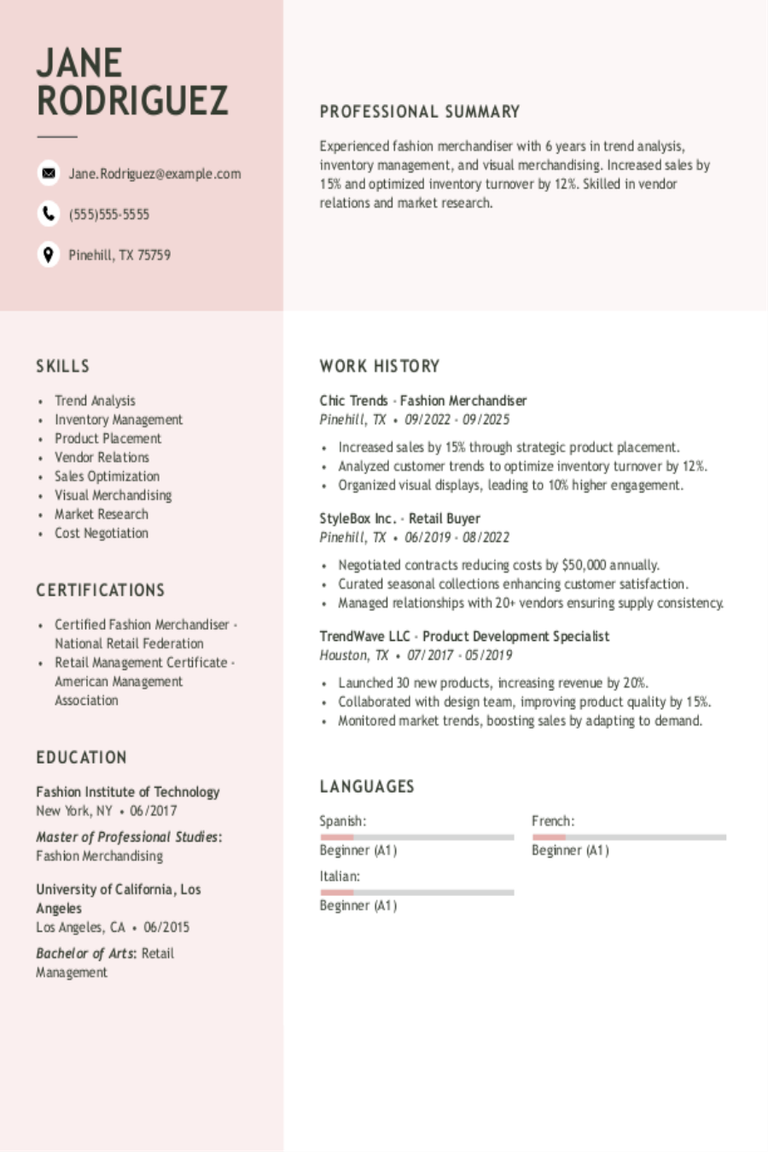
Fashion Merchandiser Resume Examples & Templates for 2025
Learn how fashion merchandisers showcase their skills in spotting trends and boosting sales. These examples and tips will help you create a resume that stands out to hiring managers by
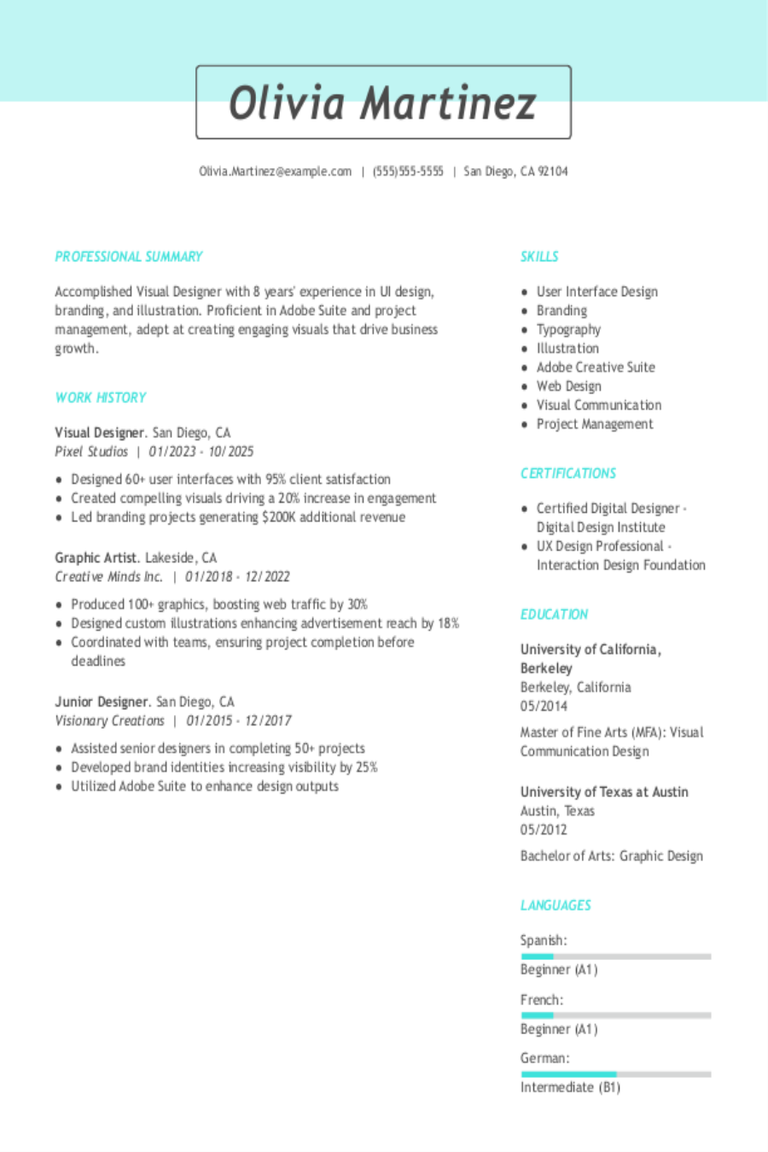
Visual Designer Resume Examples & Templates for 2025
Explore visual designer resume examples to learn how to showcase your creativity, highlight key design skills, and present projects that demonstrate your ability to turn ideas into visually compelling designs.Build
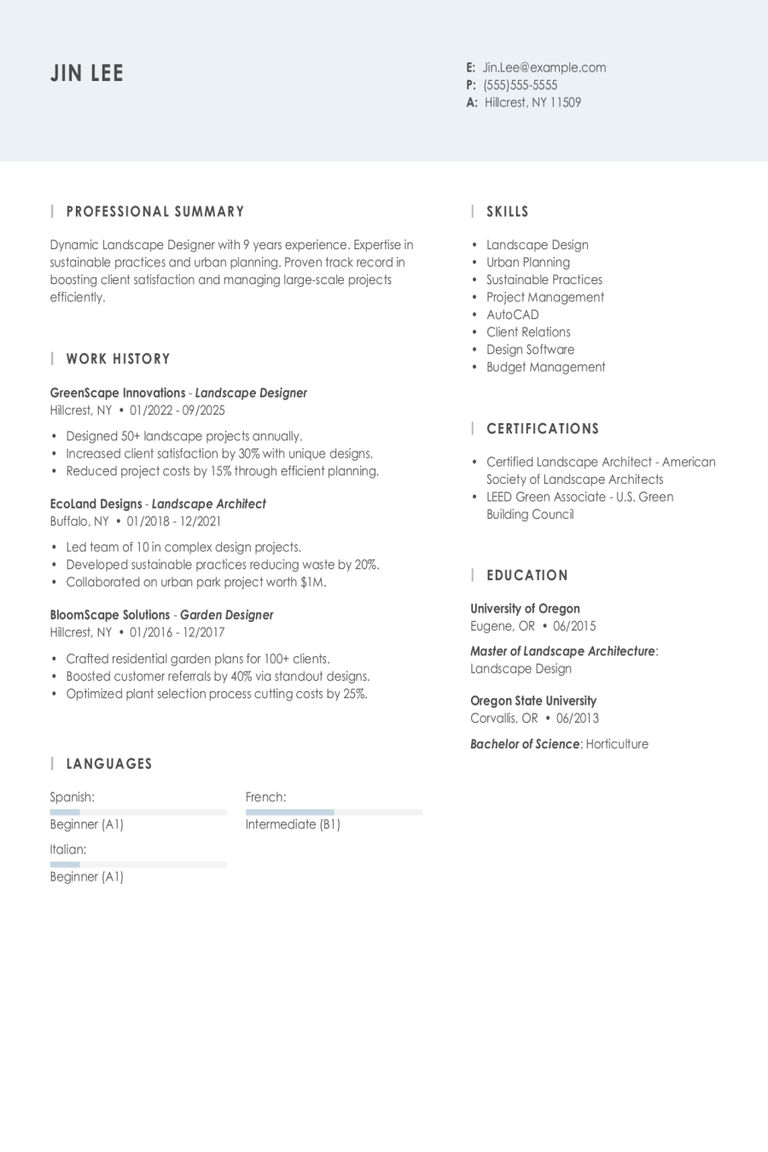
Landscape Designer Resume Examples & Templates for 2025
Browse landscape designer resume examples that show how to highlight your creativity, project planning, and plant knowledge. Learn to showcase your design skills and experience in making outdoor spaces beautiful

Fashion Resume Examples & Templates for 2025
Explore fashion resume examples to see how to highlight your design skills, trend awareness, and ability to work in fast-paced environments. Use these tips to showcase your creative projects and
